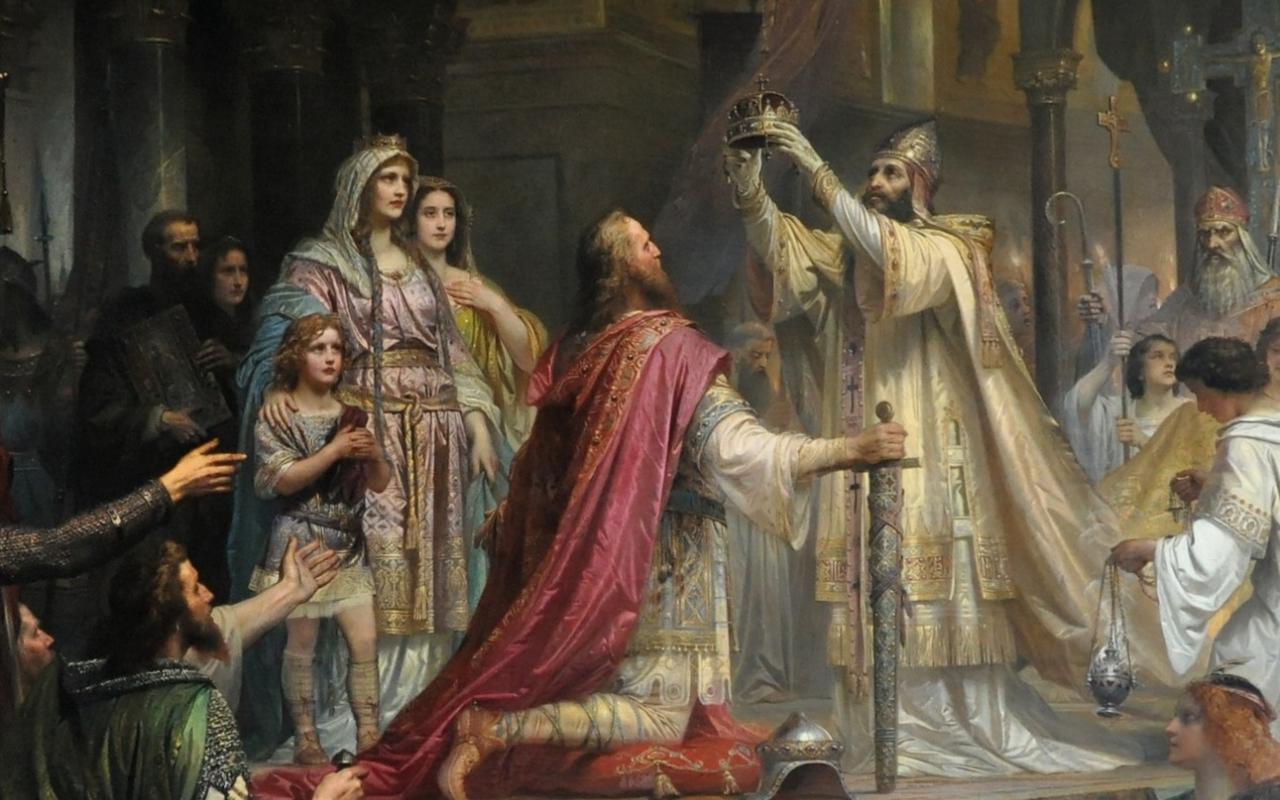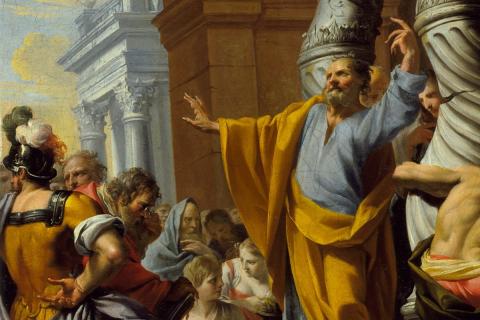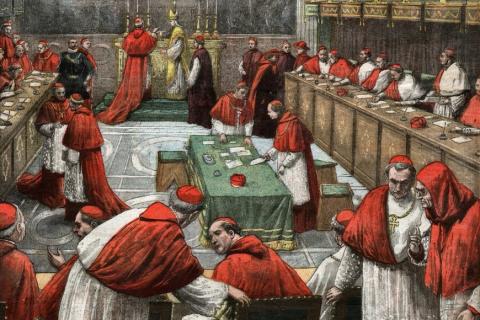
The office of Peter, the rock upon which the Church is built, may change its methods or its language, but its inner form remains. In the midst of many changes, it is essentially the same, ever ancient and ever new.
This article is the third in a five-part series on the Papacy. The series begins with “Why Did God Give Us a Pope?”
“There is not, and there never was on this earth, a work of human policy so well deserving of examination as the Roman Catholic church. The history of that Church joins together the two great ages of human civilization. The proudest royal houses are but of yesterday, when compared with the line of the Supreme Pontiffs. That line we trace back in an unbroken series, from the Pope who crowned Napoleon in the nineteenth century to the Pope who crowned Pepin in the eighth; and far beyond the time of Pepin the august dynasty extends, till it is lost in the twilight of fable. The Papacy remains, not in decay, not a mere antique, but full of life and youthful vigour” (Thomas Babington Macaulay, 1840).
Thomas Macaulay, the famous British essayist and historian, wrote these lines nearly 200 years ago. Macaulay was no friend of the Catholic Church. The son of Evangelicals, he shared with his mid-Victorian compatriots the typical anti-Catholic attitude of the time. But he was enough of an historian to perceive and acknowledge the unique and astonishing persistence shown by the Church, and particularly by the Papacy, through many ages of historical time. We might take a cue from him and briefly examine this remarkable institution. Macaulay greatly wondered at it, partly because he understood the Papacy and the Church to be a “work of human policy.” We Catholics know better. Had it been merely a human work, the Papacy would long ago have disappeared or would have been so changed by time that it would no longer be recognizable. We know that its longevity and its life and youthful vigor come, not from the humans who happen to inhabit it at any given time, but from the divine personality who established it and who daily sustains it.
We are familiar with the words Jesus spoke to his chief disciple: “You are Peter, and on this rock I will build my Church, and the powers of death shall not prevail against it” (Matthew 16:18). We might ask: what is this rock he was referring to? It was evidently not the person of Peter himself. For one thing, Peter would soon die, and the Church was founded in order to last on earth until the end of the age. For another, while Peter was no doubt an important figure in the early decades of the Church’s life, he was not the only person who was at work building the Church; many would say that St. Paul was more significant as an evangelist and apostle. The rock Jesus spoke of here was the establishment of an office, the office that has come to be called the Papacy. Peter was the first holder of that office and its special symbol and patron.
Why is this important? It is good to remember that God is the creator, not just of matter and energy and of individual immortal souls, but also of certain corporate ways of life. Humans are created to live in social harmony, and cannot survive on their own. That is why all humans naturally – that is, according to their created nature – gather themselves together in kinship groups, in political associations, in economic relationships, and in a thousand other ways. Christians have been charged to have a fundamental respect for such groupings when they are supportive of human flourishing. St. Peter tells us to “be subject for the Lord's sake to every human institution,” or, in a variant reading, to “every institution ordained for humans” (1 Peter 2: 13). Peter was speaking specifically of the Roman Empire. No one would want to suggest that God created the Roman Empire itself and established it as the one authoritative political structure for the world. In this, as in much human social organization, God did not ordain a particular institutional framework. But in that which is closest to our human identity and our destiny, he has not merely encouraged us to find ways to live together; he has given us the specific form of that corporate life. This is true of the family, and yet more notably of the Church, the two primary institutions within which we understand who we are and through which we come to the fulness of our humanity, in time and in eternity.
When God gave the Law through Moses, he did not just tell the Israelites to find ways to order their life and to worship him. He established a priesthood, and the sabbath, and an institutional framework within which his people would live. As St. Stephen noted in his preaching, "Our fathers had the tent of witness in the wilderness, even as he who spoke to Moses directed him to make it, according to the pattern that he had seen” (Acts 7:44). There was a divine pattern revealed by God that needed to be followed. Jesus, who fulfilled the Mosaic Law, continued in the same vein. He did not just tell his followers to do their best to find good ways to order their lives and their worship. He gave them a framework, a specific pattern of life that they were to follow. St. Paul wrote to Timothy that he should “Follow the pattern of the sound words which you have heard from me, in the faith and love which are in Christ Jesus” (2 Timothy 1: 13). Part of the pattern of life given by Jesus was the institution of the Papacy, an office that would be a key foundation for his continuing work in the world.
It is the world’s typical way of viewing the Church, a view that too easily becomes ours as well when we come under this world’s influence, to exaggerate the importance of individual people, and to minimize the significance of the office they hold. The Church has been graced with a number of truly remarkable popes, and has been troubled by a handful of spiritually mediocre or worse popes. Most of the men who have held the office have been somewhere in between. From a human point of view they have been adequate, if not exceptional, men of talent and wisdom. But the continued vitality of the Church has not been due mainly to the “good” popes, nor have the Church’s challenges been mainly due to the “bad” popes. It is not the individual popes, but the Papacy itself, infused by God’s life and grace beyond any human calculation, that has sustained the Church through millennia. This is not to say that it doesn’t matter if a given pope is being faithful or not to his office, nor that we have not greatly benefitted from the gifts and examples of those markedly holy and talented men who have followed Peter. God has dignified humans beyond measure by giving us genuine responsibilities for his kingdom. Our faithfulness and our gifts open avenues for God’s grace, and our unfaithfulness has serious consequences. But it is God himself, in Christ, who ultimately rules the fortunes of his people. The Papacy, founded by Christ, will be with us to the end of the age. It is ours to nourish the gift, to steward it and use it; but it is not in our power to destroy it.
The dual aspect of the Papacy as both divine and human can help explain the way the office of Peter has maintained itself through the centuries. It is a general characteristic of the Papacy that it has been consistent in its essential tasks, even while the exercise of the office has differed depending on the needs and customs of the time. St. Augustine famously wrote that God was “ever ancient and ever new,” and the same could be said of all the characteristic works of God. It is notably so as regards the Church as a whole, and the office of Peter in particular. Rooted in the Ancient of Days himself, it is yet ever putting forth new shoots, responding with the movement of the Holy Spirit to the demands of the Church as she makes her way through history toward her ultimate destiny. An earlier article noted that the office of Peter involved charisms of strengthening, proclaiming, purifying, and unifying for the sake of God’s people. We might glance very briefly at some of the ways a few of Peter’s successors have expressed those charisms through the years.
Starting with St. Peter himself: he was the evident hands-on leader of the very early band of disciples in Jerusalem. Once the Church began to be persecuted and many left Jerusalem, we hear less of Peter, though it seems that he was among the most active evangelists during those early years, while St. James the Just took responsibility for the day-to-day running of the Jerusalem Church. We can see the key role played by Peter in his contribution to the so-called Council of Jerusalem around 50 AD. After there had been “much debate,” Peter rose and described a vision he had received concerning the place of the gentiles in the Church. It is noteworthy that the Holy Spirit revealed this to Peter. After Peter spoke, “all the assembly kept silence.” Peter’s vision was reinforced by the witness of St. Paul, and so the issue was decided (Acts chapter 15). Here we see St. Peter in his office, clarifying the Gospel message and providing unity to his brothers in faith. St. Peter was also an exemplar of sacrificial love, imitating his master by his martyrdom. The mode by which St. Peter led the Church set the pattern for much of the apostolic age. His early successors as bishops of Rome did not exercise a great deal of organizational jurisdiction, leaving that to local churches, as was necessary during a time of rapid diffusion and intermittent persecution. Many of the early popes were also martyrs to the faith.
Pope St. Leo the Great (440-461) shows a development of the Papal office as it rose to the needs of its age. Pope Leo reigned during a time when the society was being widely evangelized and there was a heightened need for doctrinal clarity and organizational coherence. He was living among a largely Christian population, and as the Roman political structure weakened in the West, he emerged as a key leader for the whole of Rome and central Italy. It was Pope Leo who famously confronted Attila the Hun and negotiated a truce by which Attila withdrew from Italy and Rome was preserved from destruction. A pious story has it that Attila was given a vision of Saints Peter and Paul in gigantic form with drawn swords standing on either side of Pope Leo. Whether literally true or not, the story suggests something of the spiritual solidity and strength of the Papal office. It was not merely a “human policy,” but had roots in the powers of heaven. Pope Leo also played a decisive role at the Council of Chalcedon, where his famous Tome became the accepted expression of orthodox faith regarding the union of the divine and human in Jesus. We can see Peter’s office here as giving strength in the face of both physical and spiritual chaos, and providing clarity and unity to the Church.
Pope St. Gregory the Great (590-604) became pope at a time of increasing social chaos as the slow fade of the Western Roman Empire meant that new cultural forces were at work, and Christians were increasingly under pressure from pagan peoples. Pope Gregory initiated an evangelistic mission to the Angles and Saxons of England under the direction of Augustine, the first Archbishop of Canterbury. He won some of the Germanic peoples back from the heresy of Arianism. He was also a significant force in liturgy; the Church’s favored chant still bears his name. In him we can see Peter’s office as a foundation, a rock, for an emerging phase of the Church’s life. Through his activity among various northern peoples, his writings, and his church organization, Pope Gregory paved the way for a fresh expression of the faith and began a process that set the foundation for the whole medieval period. As the Roman empire seemed to be growing old, the Church was putting forth new life.
Pope St. Gregory VII (1073-1085) became pope at a time when the European world was on the cusp of a great civilizational development. Cities were growing, population was rising, and the society was becoming ever more sophisticated. The Church was intertwined with the wider society, but worldly patterns had developed that were blunting her witness and her flexibility to meet new demands. Pope Gregory initiated one of the most significant reforms in Church history, purifying the priesthood, bringing monastic life back to its origins, and reminding temporal rulers, particularly the Emperor, that their authority, though real, was limited. He exercised his office in a time of increasing complexity, and by his organizational genius helped the Church to prepare for a new outpouring of the Holy Spirit, soon to come through the lives and apostolic ministries of St. Bernard, St. Francis, and St. Dominic, among others.
Pope St. Pius V (1566-1572) exercised Peter’s office at a time when the medieval synthesis had been shattered, first by the Great Schism and then by the Protestant Reformation. It was a time of both spiritual and political chaos, a time when strengthening the faithful and clarity of doctrine were particularly needed. Pope Pius worked strenuously to bring order to the Church, promoting the study of Thomas Aquinas and overseeing the implementation of the Council of Trent. Even as he strengthened the internal life of the Church, he organized Christian rulers to unite against the expansionist challenge of the Ottoman Turks, and lived to see the victory of the Christian fleet at the battle of Lepanto.
Each of these Popes were men of holiness of life, of prayer and charity. They were also highly talented people. Yet most significant in their labors and the main source of their potency was that they expressed, in a way suited to the needs and opportunities of their time, the spiritual office of Peter. As the Church has penetrated different societies, evangelized new peoples, and faced challenges both internal and external, the Papal office has responded, under grace, to the action of the Holy Spirit in strengthening, purifying, and uniting the Christian people. Not all of the successors of St. Peter have possessed the talent or the holiness of those mentioned above. But all have participated in the spiritual graces of the office as Christ has sustained his Church on the rock that he himself established.
Much might be said of the great changes in human society during the last two hundred years or so, changes more significant than any in recorded history. The rise of a technological order with all its potentialities and dangers, with its many effects on social and individual life, have meant that the Church, ever ancient and ever new, has been called upon to preach the truth and to construct a true home for humanity under unprecedented conditions. We have seen any number of impressive popes during these past two centuries, and have seen the exercise of Peter’s office take on new dimensions. The modern Papacy is very different in many details from what came before it. To note just a few significant developments: due to the technological and communication revolution the Pope is now a familiar and recognized personality around the world, something that was impossible before the rise of a world press and electronic mass media. This has placed a different set of demands upon the office. Again, since the French Revolution and the increasing secularization of many formerly Christian societies, along with the growing complexity of modern organizational life, the Papacy has found itself at the hub of a far-flung centralized administrative structure. And again, partly due to the increasing connectedness of societies and cultures around the world, and partly due to an ever-more international body of believers as the fruits of evangelization have spread to every corner of the globe, the Papacy has become a focal point of world leadership to an unprecedented degree.
Yet in the midst of these and other significant societal changes that continue to shape the modern world, the fundamental task of the Papacy remains. The office of Peter, the rock upon which the Church is built, may change its methods or its language, but its inner form remains. It continues to proclaim and clarify doctrinal truth, to be a symbol and an instrument of unity, and to strengthen the faithful around the world. In the midst of many changes, it is essentially the same, ever ancient and ever new. While we rightly hope that the men chosen to succeed St. Peter bring to their task both great holiness and requisite human talents, it remains true that the strength and consistency of the Papal office over time rest squarely upon the Lord who founded it, and whose life and truth it expresses. Ultimately, the rock of St. Peter is founded upon the Rock who is Christ. And as all the faithful know, “Jesus Christ is the same yesterday and today and forever” (Hebrews 13:8).

